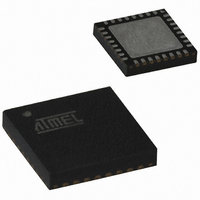AT89C5131A-PUTUM Atmel, AT89C5131A-PUTUM Datasheet - Page 155

AT89C5131A-PUTUM
Manufacturer Part Number
AT89C5131A-PUTUM
Description
IC 8051 MCU FLASH 32K USB 32QFN
Manufacturer
Atmel
Series
AT89C513xr
Datasheet
1.AT89C5130A-PUTUM.pdf
(188 pages)
Specifications of AT89C5131A-PUTUM
Core Processor
C52X2
Core Size
8-Bit
Speed
48MHz
Connectivity
I²C, SPI, UART/USART, USB
Peripherals
LED, POR, PWM, WDT
Number Of I /o
18
Program Memory Size
32KB (32K x 8)
Program Memory Type
FLASH
Eeprom Size
4K x 8
Ram Size
1.25K x 8
Voltage - Supply (vcc/vdd)
2.7 V ~ 5.5 V
Oscillator Type
Internal
Operating Temperature
-40°C ~ 85°C
Package / Case
32-VQFN Exposed Pad, 32-HVQFN, 32-SQFN, 32-DHVQFN
Core
8051
Processor Series
AT89x
Data Bus Width
8 bit
Maximum Clock Frequency
48 MHz
Data Ram Size
1.25 KB
Number Of Programmable I/os
34
Number Of Timers
16 bit
Operating Supply Voltage
2.7 V to 5.5 V
Mounting Style
SMD/SMT
Height
0.95 mm
Interface Type
2-Wire, EUART, SPI, USB
Length
7 mm
Maximum Operating Temperature
+ 85 C
Minimum Operating Temperature
- 40 C
Supply Voltage (max)
5.5 V
Supply Voltage (min)
2.7 V
Width
7 mm
For Use With
AT89OCD-01 - USB EMULATOR FOR AT8XC51 MCUAT89STK-10 - KIT EVAL APPL MASS STORAGEAT89STK-05 - KIT STARTER FOR AT89C5131
Lead Free Status / RoHS Status
Lead free / RoHS Compliant
Data Converters
-
Lead Free Status / Rohs Status
Details
Available stocks
Company
Part Number
Manufacturer
Quantity
Price
Part Number:
AT89C5131A-PUTUM
Manufacturer:
ATMEL/爱特梅尔
Quantity:
20 000
24. Power Management
24.1
24.2
4337K–USB–04/08
Idle Mode
Power-down Mode
An instruction that sets PCON.0 indicates that it is the last instruction to be executed before
going into the Idle mode. In the Idle mode, the internal clock signal is gated off to the CPU, but
not to the interrupt, Timer, and Serial Port functions. The CPU status is preserved in its entirety:
the Stack Pointer, Program Counter, Program Status Word, Accumulator and all other registers
maintain their data during Idle. The port pins hold the logical states they had at the time Idle was
activated. ALE and PSEN hold at logic high level.
There are two ways to terminate the Idle mode. Activation of any enabled interrupt will cause
PCON.0 to be cleared by hardware, terminating the Idle mode. The interrupt will be serviced,
and following RETI the next instruction to be executed will be the one following the instruction
that put the device into idle.
The flag bits GF0 and GF1 can be used to give an indication if an interrupt occurred during nor-
mal operation or during an Idle. For example, an instruction that activates Idle can also set one
or both flag bits. When Idle is terminated by an interrupt, the interrupt service routine can exam-
ine the flag bits.
The other way of terminating the Idle mode is with a hardware reset. Since the clock oscillator is
still running, the hardware reset needs to be held active for only two machine cycles (24 oscilla-
tor periods) to complete the reset.
To save maximum power, a power-down mode can be invoked by software (refer to Table 13,
PCON register).
In power-down mode, the oscillator is stopped and the instruction that invoked power-down
mode is the last instruction executed. The internal RAM and SFRs retain their value until the
power-down mode is terminated. V
reset or an external interrupt can cause an exit from power-down. To properly terminate power-
down, the reset or external interrupt should not be executed before V
operating level and must be held active long enough for the oscillator to restart and stabilize.
Only:
are useful to exit from power-down. For that, interrupt must be enabled and configured as level
or edge sensitive interrupt input. When Keyboard Interrupt occurs after a power down mode,
1024 clocks are necessary to exit to power-down mode and enter in operating mode.
Holding the pin low restarts the oscillator but bringing the pin high completes the exit as detailed
in Figure 24-1. When both interrupts are enabled, the oscillator restarts as soon as one of the
two inputs is held low and power-down exit will be completed when the first input is released. In
this case, the higher priority interrupt service routine is executed. Once the interrupt is serviced,
the next instruction to be executed after RETI will be the one following the instruction that put
AT89C5130A/31A-M into power-down mode.
• external interrupt INT0,
• external interrupt INT1,
• Keyboard interrupt and
• USB Interrupt
CC
can be lowered to save further power. Either a hardware
AT89C5130A/31A-M
CC
is restored to its normal
155

















